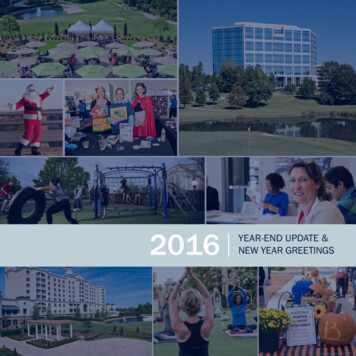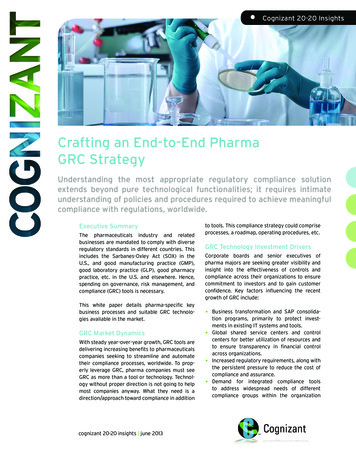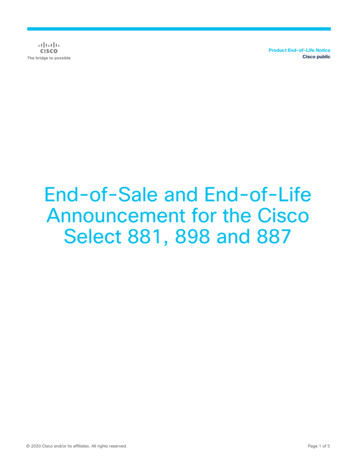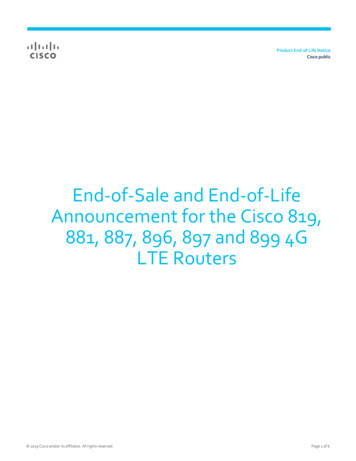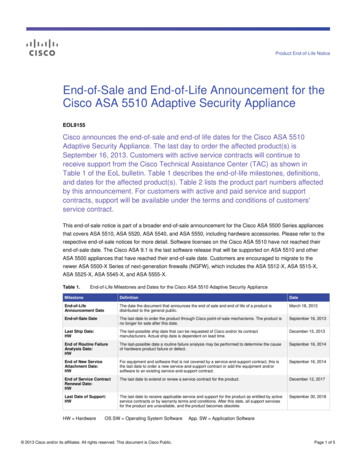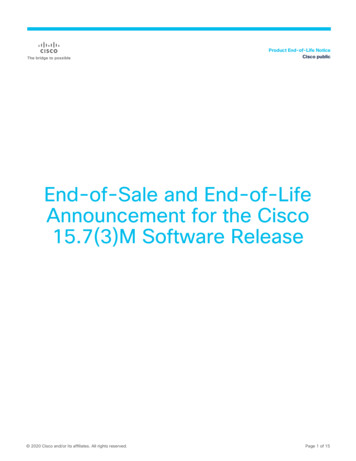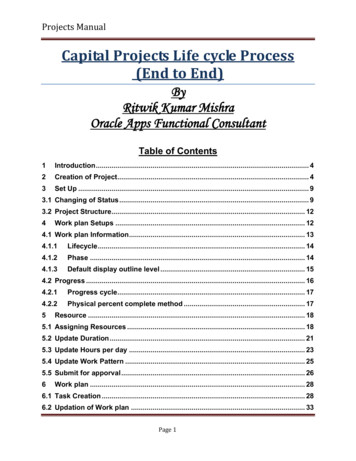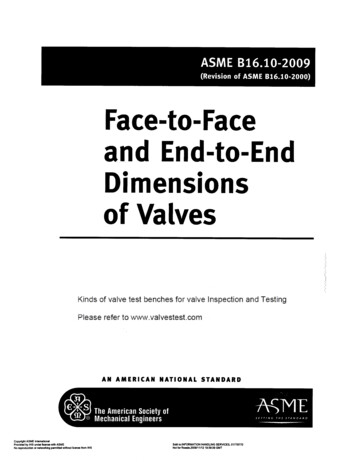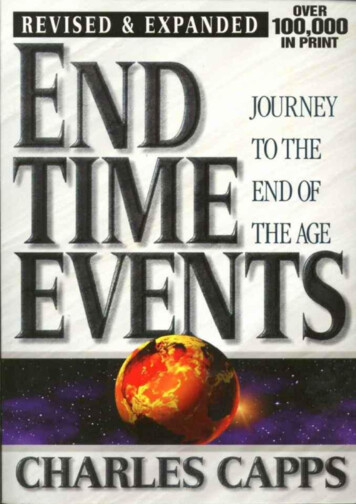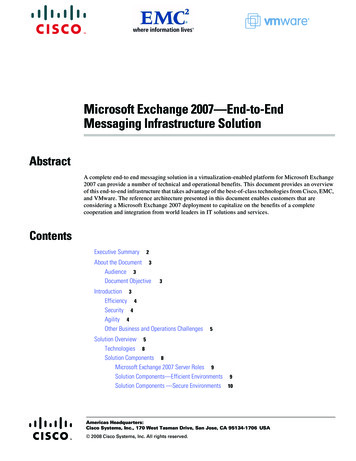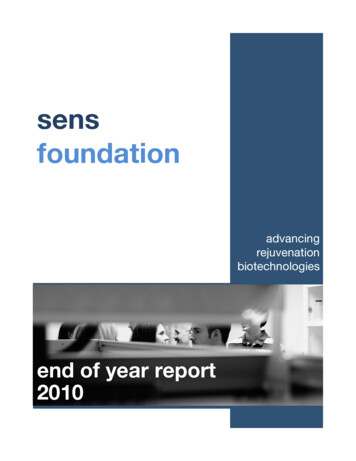
Transcription
grejuvenationbiotechnologiesend of year report2010!
sens foundation!end of year report 2010!sensf eoy 2010v3.1!
“In 2009 we launched SENS Foundation.We did it to drive biomedical research towards a functional and cost-effectiveapproach to extending individual health. We did it to raise awareness for analternative to an increasingly complex and problematic pathology chase inmedicine; to redefine regenerative medicine as applied to aging; to enabledoctors to think about fixing patients before they were sick.We did it to transform the way you think about medicine.We knew it was a big agenda when we set out, and we were fully conscious of howsmall a public charity we were. We recognized that our first successful steps woulddepend upon our demonstration of fundamental credibility to the medical sciencecommunity.That is why I am especially pleased to present this We have found our voice with2010 end of year report. As you will read, wea substantial and mainstreamhave created a mature organization and deliveredthe networks and collaborations needed to buildscientific community. !the rejuvenation biotechnology field. We’veexpanded our own research programs and have used that expansion to developcollaborations with leading universities and research institutions in regenerativemedicine, around the nation and the world.We have, in short, found our voice with a substantial and mainstream scientificcommunity. Rejuvenation biotechnology, as a research field, is emerging, and SENSFoundation has led that charge. For that, our thanks go to all of you, our researchers,supporters, and stakeholders.We intend to use the voice we have earned. Regenerative medicine and stem cellresearch now bring in immense state, federal, and international funding. That kind offunding has put spectacular advances in organ replacement and tissue repair, forexample, on the horizon. However, rejuvenation research - the application of thosesame regenerative concepts to the damage and diseases of aging - still receives alltoo little attention.It is amazing that you might someday be able to receive a newly made heart, kidney,or liver. But in theory, there are damage repair interventions that could be simpler,cheaper, and made more widely available than that, and many of them remaincompletely unexplored. We need to fix that, and for that we need your continuedsupport.michael kopeco-founder, ceosens foundation”
“SENS Foundation’s research strategy is to support a mix of intramural work at ourResearch Center and extramural projects at university laboratories elsewhere. I amdelighted with both our research progress and the expansion of its scope in 2010.At the Research Center we have hired five additional full-time and one part-time staff,including Tanya Jones, our Director of Research Operations. We now boast twovibrant projects, within our LysoSENS and MitoSENS strands.Our three-strong LysoSENS team is pursuing enzymatic solutions to the problem ofeliminating two of the most notable components of age-related “molecularaggregates” – A2E and 7-ketocholesterol (7KC). A2E is a major cause of dysfunctionof retinal epithelial cells, producing age-related macular degeneration (AMD), theleading cause of blindness in the elderly. 7KC, an oxidized derivative of cholesterol, isbelieved to be a major cause of the degeneration of macrophages into foam cells,which is the first step in atherosclerosis, one of the most lethal age-related diseasesworldwide.Our team has developed an in-houseprocess for A2E synthesis, a critical step inour screening and evaluation programs forA2E-degrading enzymes. One suchcandidate has been dramatically enhanced by fusion with a second enzyme,accelerating the rate of degradation of A2E up to 100-fold. On the 7KC side, we haveidentified a number of 7KC-metabolising enzymes, and have successfully subclonedthem into a species of yeast which will allow us to determine whether the activity of aparticular enzyme will be preserved if expressed in humans. We are developingmethods for transfecting these enzymes into macrophages, to determine whethertheir expression can reverse the foam cell phenotype.I am delighted with our researchprogress and expansion in 2010. !SENS Foundation launched its second major in-house project in the MitoSENSstrand, hiring Dr. Matthew O’Connor as research leader in September 2010, andmore recently adding Dr. Gayathri Swaminathan to the team. Allotopic expression –the addition of mitochondrially-encoded genes to the nucleus, protecting them fromoxidative damage – is expected to relieve many aging-related pathologies, includingsarcopenia (loss of muscle with age). Allotopic expression has beendemonstrated for three of the thirteen genes required to complete theprocess in humans: our former collaborators – the group of Dr. MarisolCorral-Debrinski – were responsible for much of this progress. The goalof the new project is to demonstrate allotopic expression of theremaining ten genes, individually and in combination.dr aubrey de greyco-founder, chief science officersens foundation
“In addition to these major projects, a team at the Research Center developed aprototype “scrubber” – a device able to selectively deplete “anergic”(proliferation-resistant) T cells (a type of white blood cell) from the bloodstreamof mice. This depletion was demonstrated to result in a long-term return to amore youthful T cell profile, and led to an academic publication and patent. Theprototype has since been loaned to our extramural collaborator Dr. JankoNikolich-Zugich, to conduct further studies.In extramural research, progress has been similarly heartening.In the lab of Dr. Janko Nikolich-Zugich at Arizona University, we have funded work byDr. Megan Smithey exploring the relationship between persistent viral infections andimmunosenescence, the reduced capacity of the aged immune system to respond toinfections. This project has made several exciting discoveries. Most notable is adramatic improvement in immune response when T cells from young adult mice aretransferred into older mice partially depleted of their own T cells, strongly indicatingthat the decline in function of T cells in aged individuals is due to an intrinsic defect ofthese cells. The continuation of this work in 2011 is expected to provide sufficientdata to allow clinical testing to begin.In the fall, we initiated two projects: one on removing senescent cells (Kevin Perrott inthe lab of Dr. Judith Campisi at the Buck Institute), and one designed in collaborationwith the Supercentenarian Research Foundation’s Stan Primmer, involving Drs.Sudhir Paul of the University of Texas and Brian O’Nuallain of Harvard University.This latter project targets senile systemic amyloidosis and isolated atrial amyloidosis.Both are caused by the aggregation of proteins to form damaging amyloids, leadingto significant age-related disorders of heart function. The goal is to developantibodies able to detect and destroy these aggregates.We continue to fund extramural LysoSENS work by Jacques Mathieu and RobO’Callahan in the laboratory of Prof. Pedro Alvarez at Rice University. This team hasrecently produced two enzymes with activity against 7KC, currently being takenforward into cell-based assays. They have also begun development of a selectionbased assay for mutagenesis libraries – a key step in high-throughput “directedevolution” of the enzymes already discovered.Also in 2010, SENS Foundation began a multi-project collaboration with theworld-leading Wake Forest Institute for Regenerative Medicine. Projects in theareas of immunosenescence, extracellular matrix cross-linking, andintracellular aggregates will start in 2011, conditional on sufficient funding.dr aubrey de greyco-founder, chief science officersens foundation.
“Finally, our credibility within the broader academic community has been confirmed bythe addition to our Research Advisory Board (RAB) of Dr. Ana Maria Cuervo, a worldrenowned specialist in the role of lysosomes and autophagy in aging-related disease,and Dr. Daniel Kraft, an international expert in stem cell biology and therapeutics. TheRAB now consists of seventeen highly prestigious scientists with expertisespanning the full range of rejuvenation biotechnologies: their endorsement ofour approach and research can be found on the SENS Foundation website.Research Focus:Role of Epimutationsin Organismal AgingIn 1959, Leo Szilard published a paper proposing that randommutations of the genome, accumulating throughout life, wouldlead inevitably to a derangement of metabolism throughout thebody, resulting in aging and death. More recently, a secondtype of DNA damage – epimutation – has been recognized.Both mutations and epimutations accumulate with age, and both are instrumental in cancer. Thethreat from cancer-causing DNA damage is radically greater than from other types, since a singlecancerous cell can kill. There is a theory that organisms susceptible to cancer will evolve suchpowerful genome maintenance mechanisms that non-cancerous DNA damage will be kept wellbelow a critical level in a currently normal lifetime. Thus, we do not expect the capability to repairmutations or epimutations to be required in a comprehensive rejuvenation biotechnology platform,as long as that platform includes a cast iron defence against cancer. It is important, therefore, thatwe confirm the theory is correct, such that we can safely avoid the need to develop robust DNArepair so long as we can thoroughly prevent cancer (which is another SENS strand).At Albert Einstein College of Medicine in New York, SENS Foundation has been funding Dr. SilviaGravina in the lab of Dr. Jan Vijg, to evaluate whether random changes in DNA methylation (a majortype of epimutation) are sufficiently widespread to have a significant impact on the aging process.The standard protocol for studying these changes involves conditions which typically lead toextensive DNA degradation. This is a particularly serious issue for single-cell analysis, which ourwork requires in order to detect bona fide adventitious changes, rather than ones made “onpurpose” by the cell in response to other types of damage. Dr. Gravina’s first success was inoptimizing conditions to minimize such degradation. She was then able to demonstrate that heroptimized protocol was effective in single cells of several types – hepatocytes, fibroblasts, andneurons.A far more reliable assessment of damage can be derived through comprehensive, gene-specificmeasurements, and Dr. Gravina is now developing this approach using so-called “next-generation”sequencing. Preliminary results are very promising.An additional requirement for this project is a new method for isolating the target DNA: existingtechniques are not effective for neurons, due to their complex and fragile structure. To meet thisrequirement Dr. Gravina has developed a protocol to enrich single neuronal nuclei.Drawing together all of these preliminary achievements, Dr. Gravina is now working directly on ourproject’s ultimate aim – quantifying genome-wide levels of epimutation in the nuclei of singleneurons from aged mice – with key results expected in 2011. The interim results are currently beingprepared for academic publication in a leading peer-reviewed journal.dr aubrey de greyco-founder, chief science officersens foundation”
“2010 saw the Foundation take majorsteps in clarifying and delivering itsmessage. In November our CEO, MikeKope, delivered a speech as part ofBreakthrough Philanthropy, which wasthe clearest statement to date of ourmission: a video is available at sens.org.In Los Angeles we began to hold regularmeetings, bringing together supporters,donors, scientists, industry experts andFoundation staff. Those meetings were usedas a ‘test bed’ for a wider, global outreachprogram. Their organizer, Maria Entraigues,has now joined our team as Global MeetingCoordinator.In 2010 we organized sessions at three majorinternational conferences, including theGenetic Policy Institute’s World Stem CellSummit, in Detroit, MI. Our focus is now onthe fifth SENS Conference which will be held inCambridge, England in autumn 2011.Staff Focus: Maria EntraiguesMaria Entraigues is SENS Foundation's GlobalMeeting Coordinator (and also our VolunteerCoordinator).Maria was born in Buenos Aires, Argentina andis now an American citizen. She moved toAmerica in 1992 to study under a scholarship atBerklee College of Music, Boston beforeestablishing herself in Los Angeles as asinger. She's written songs and performed asa soloist singer and actress for several featurefilms, commercials, musicals, and TV shows.In 2004, her interest in science, particularly theaging process, led her to volunteer to help Dr.Aubrey de Grey and theSENS program.Among her many interestsand activities she is also apilot, flight school ownerand Cultural Attaché of theArgentine Consulate in LA.On-line, we upgraded our website, and began a greater level of integration with socialnetworking sites such as Facebook and Twitter. Work is currently underway for afurther iteration of the site, to increase the general accessibility of information aboutthe Foundation, and better serve the needs of our donors and supporters.Our Academic Initiative continued to support the next generation of researchers inrejuvenation biotechnologies. Tyler James joined us as Coordinator for the program,undertaking a great deal of behind-the-scenes work to restructure and streamline theInitiative, prior to our planned roll-out of new, for-credit university courses inrejuvenation biotechnology.Looking ahead, we are reframing some of our thoughts in terms of the biotechindustry. Healthcare costs continue to escalate, without concomitant rises inhealthspan, a trend which will create individual, economic, and societalconsequences. We believe the time has come to talk about the potential forchange which rejuvenation biotechnology can bring to the way we address theseissues, and to healthcare efficiencies in age-related disease.dr sarah marrco-founder, executive vice presidentsens foundation”
“Over the past year, the infrastructure of SENS Foundation's Research Center hasexpanded significantly. We recently relocated to a new facility, more than tripling ouravailable space. Extensive renovations converted the space from an empty shell intoa fully operational lab environment, greatly extending the capabilities of our previousincubator space. A successful ‘lab warming’ event at the end of renovationsgenerated donations and the loan of several items of required equipment.Since the beginning of 2010, our Research Center has expanded to astaff of seven, and the new facility allows for the addition of severalmore researchers. This growth has allowed us to accelerate researchon the LysoSENS project and to expand our work to include MitoSENS.relaxing outside the Research Center at the ‘lab warming’tanya jonesdirector of research operationssens foundation.
“Obtaining new lab space hasalso proven critical to our abilityto perform research, removingdiverse problems and providingan independent, clean and highquality environment.This has been a year about infrastructurefor the Research Center: establishing aprofessionally managed laboratory toserve as the foundation on which we canbuild our research program.We are particularly delighted to haverecruited two scientists who each haveover four years of post-doctoralexperience in top universities. Dr.Gayathri Swaminathan will shortly bejoining Dr. Matthew O’Connor on ourMitoSENS team. From one hundredexcellent applicants, we were fortunateto have our top candidate accept aposition with the Foundation.Dr. Swaminathan is an expert cellbiologist, and we look forward toher joining us at the ResearchCenter at the beginning ofMarch.”Researcher Focus:Matthew O’ConnorMatthew "Oki" O'Connor joined us in September. He isa research scientist, specializing in the cellular basis ofthe aging process.Dr. O'Connor first became interested in the biology ofaging when reading about telomeres in ScientificAmerican when he was sixteen years old. He won anearly entrance to college and received his B.S. fromShimer College and M.S. in Molecular Biology fromNorthwestern Medical School, where he studiedlearning and memory. At Baylor College of Medicinehe earned his Ph.D. in Biochemistry for his workcharacterizing the proteins which protect and regulatetelomeres.In 2006 Dr. O'Connor decided to follow the so-called‘California Gold Rush’ in stem cell research to t of UC Berkeley, studying muscle stemcells. He presented some of his results at the thirdSENS conference in Cambridge, England.Now at the SENS Research Center in Mountain View,California to head our MitoSENS project, Dr. O'Connoris excited to be working on mitochondrialrejuvenation: "MitoSENS has the potential to transformthe way we think about the accumulation of cellulardamage caused by free radicals."tanya jonesdirector of research operationssens foundation
2010 financesSENS Foundation received 1,356,000 of donations in 2010. In addition to expressing ourgratitude for all the donations which we received, we would like to thank Peter Thiel,Jason Hope and Dan Stoicescu for their generous support of the Foundation.Our total expenditure was 1,119,000.68% of our expenditure went on intra- and extramural research, including grants toexternal facilities, direct payment of external researchers, our CSO and his support team,and costs of the SENS Foundation Research Center (including staffing costs, facilities andoperational costs, and relocation costs).In total, 73% of expenditure was attributable to charitable purposes, including research,and outreach through the Academic Initiative and Foundation events.!administrationlegal and accounting costsstaff 26,000 205,000 231,000sens foundation events 14,000extramural research 428,000generaloperating coststravel and attendance 14,000 54,000 68,000academic initiative 41,000intramural researchchief science officer and teamfacilities, equipment, operating costsresearch center staff 120,000 68,000 149,000 337,000!incomethrough Methuselah Foundationdirect donations 222,000 1,134,000 1,356,000sens foundationyear end report 2010www.sens.org* figures are given to nearest 1,000* calculations based on cash and accruals positions for 2010sens foundation is a 501(c)(3) public charity
sens foundation In 2009 we launched SENS Foundation. . funding has put spectacular advances in organ replacement and tissue repair, for example, on the horizon. However, rejuvenation research - the application of those .
